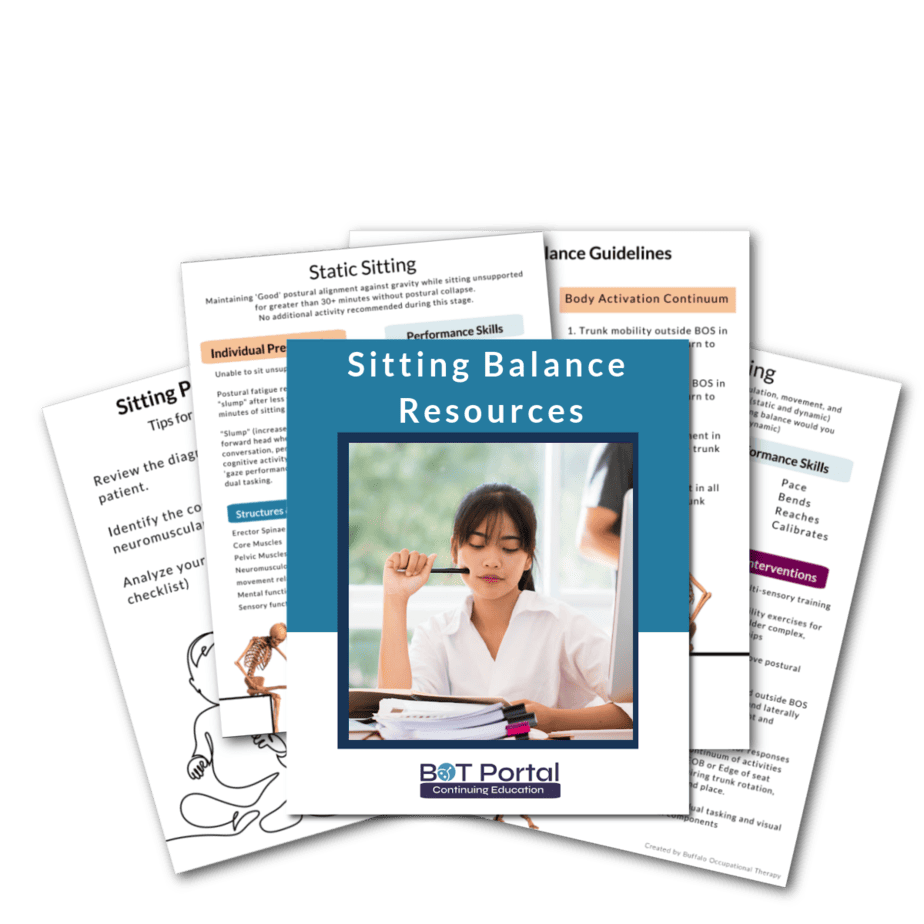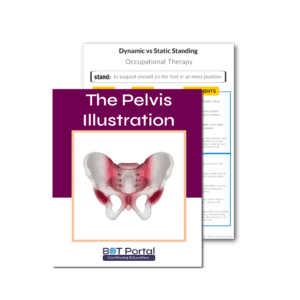Description
Sitting Balance Resources
Note: These are ideas to inform daily practice. Many research-supported intervention trajectories are shown to promote remediation, and everyone is different! Do your research! This is merely a tool in your toolkit. 🙂
In occupational therapy, educating individuals on the concepts of balance, posture, and dynamic versus static sitting balance is crucial for optimizing occupational performance and promoting overall well-being, particularly in sedentary occupations or activities requiring prolonged sitting. Balance and posture are fundamental components of daily activities, influencing comfort, stability, and efficiency during tasks such as desk work, driving, or sitting for leisure activities. By understanding the importance of these concepts in occupational performance, individuals can improve their ability to engage in seated tasks safely, comfortably, and effectively.
Dynamic sitting balance refers to the ability to maintain stability and control while seated and in motion, such as shifting weight, reaching for objects, or adjusting posture. It is essential for activities that involve movement or changes in position while sitting, such as reaching across a desk to grab a file, turning to answer a phone call, or transferring items from one surface to another. For instance, a person may need to maintain dynamic sitting balance while twisting to grab a pen, adjusting their posture to reach for a keyboard, or leaning forward to read a document. Occupational therapy emphasizes the importance of dynamic sitting balance in occupational performance, as it directly impacts an individual’s ability to perform seated tasks with ease and efficiency. By incorporating dynamic sitting balance exercises and strategies into therapy sessions, occupational therapists help individuals develop the skills and confidence needed to maintain stability and control while seated, reducing the risk of discomfort, fatigue, and injury during prolonged sitting activities.
Static sitting balance, on the other hand, refers to the ability to maintain stability and control while seated and stationary, such as sitting upright without support or maintaining a neutral spine alignment. While static sitting balance may seem less dynamic, it is equally important for activities that require maintaining a stable posture or position while seated for extended periods. For example, individuals need this skill to maintain proper posture while typing on a computer, sitting in a meeting, or eating a meal. Occupational therapy recognizes the significance of static sitting balance in occupational performance, as it forms the foundation for various seated tasks and activities. By addressing these deficits and promoting proper posture alignment, occupational therapists help individuals improve their comfort, endurance, and productivity during prolonged sitting, enhancing overall occupational performance and quality of life.
Educating individuals on the concepts of balance, posture, and dynamic versus static sitting balance empowers them to take an active role in their health and well-being during seated activities. Occupational therapy provides individuals with the knowledge, skills, and strategies needed to maintain optimal balance and posture while sitting, whether at work, school, or home. By fostering awareness of their sitting habits, body mechanics, and environmental factors, individuals can make informed decisions and implement adaptive strategies to support their occupational goals and prevent long-term musculoskeletal issues associated with poor sitting posture. Through education, training, and support, occupational therapy helps individuals achieve optimal seated balance and posture, enabling them to engage in seated activities with comfort, confidence, and efficiency.
Some other helpful links:
Check out BOT Portal: Resource Site for Occupational Therapy Students and Practitioners




